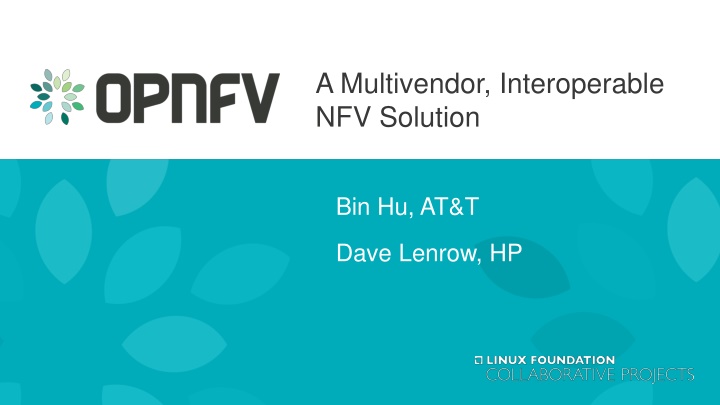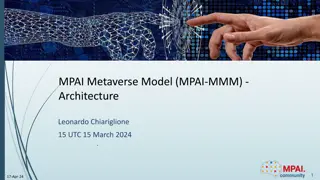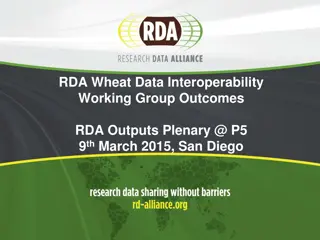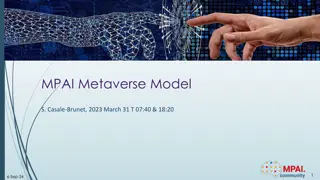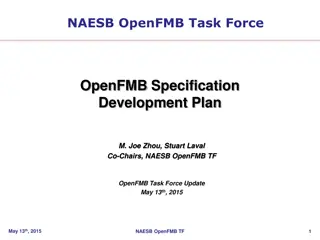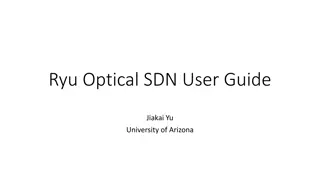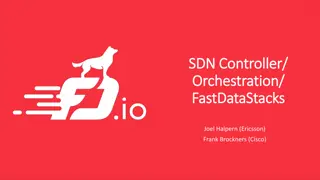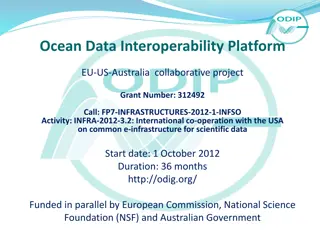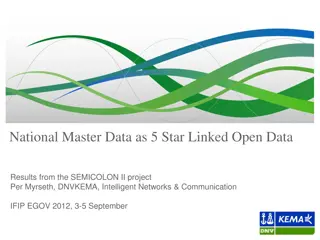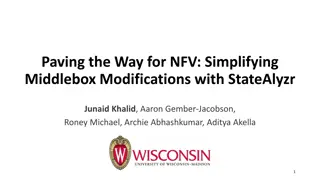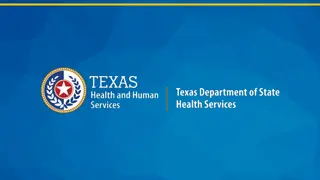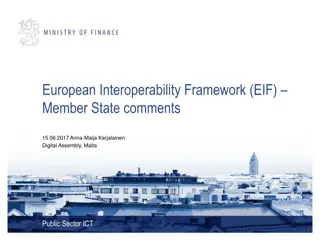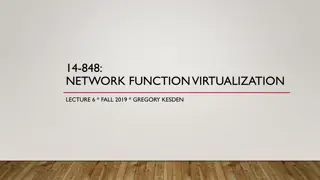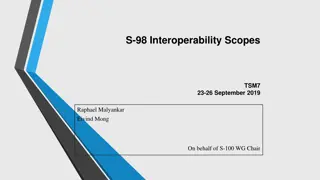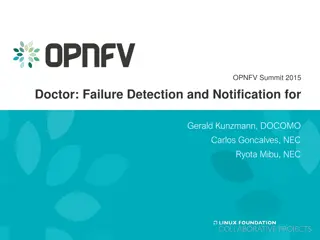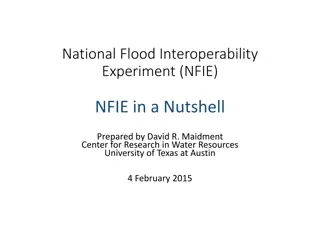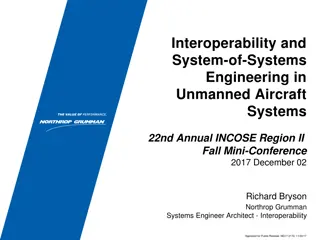A Multivendor NFV Solution for Enhanced Interoperability
The evolving landscape of NFV solutions with a focus on multivendor interoperability. Discover the potential for new use cases, services, and business opportunities in the ever-changing world of network functions virtualization. Dive into the OPNFV Vision and delve deeper into the background and objectives of the Proof of Concept for Infrastructure-as-a-Service. Learn about the user experience and benefits of leveraging OPNFV-compliant infrastructures to enhance service coverage and synchronization between environments."
Download Presentation

Please find below an Image/Link to download the presentation.
The content on the website is provided AS IS for your information and personal use only. It may not be sold, licensed, or shared on other websites without obtaining consent from the author.If you encounter any issues during the download, it is possible that the publisher has removed the file from their server.
You are allowed to download the files provided on this website for personal or commercial use, subject to the condition that they are used lawfully. All files are the property of their respective owners.
The content on the website is provided AS IS for your information and personal use only. It may not be sold, licensed, or shared on other websites without obtaining consent from the author.
E N D
Presentation Transcript
A Multivendor, Interoperable NFV Solution Bin Hu, AT&T Dave Lenrow, HP
Agenda OPNFV Vision PoC Background PoC #1 OPNFV IaaS PoC #2 OPNFV Site Failover Next Steps Acknowledgement 2025-03-10
OPNFV Vision Multivendor, interoperable NFV solutions Consistency, performance and interoperability among NFVIs Unlimited potential of new use cases, services and business 2025-03-10
POC Background The PoCs were completed prior to release of OPNFV Arno They used the Arno upstream components (OpenStack, OpenDayLight, OVS, etc.) They used vendor supported, generally available distributions of those upstream components, considered more deployable than the raw upstream currently They used prototype / PoC-specific APIs and code to create some of the advanced features which don t yet have upstream support. 2025-03-10
PoC #1 OPNFV Infrastructure-as-a-Service Interoperability aspects of OPNFV-I that are independently administered Unify services across separate domains of OPNFV environments Leverage partners OPNFV environments to expand service coverage 2025-03-10
PoC #1 OPNFV Infrastructure-as-a-Service Objectives Demonstrate interoperability between OPNFV-compliant infrastructures-as-a-Service environments ( OPNFV-I ) Demonstrate VNF migration to separately administered OPNFV-I environments Demonstrate federated OPNFV-I environments enable live synchronization between the environments 2025-03-10
PoC #1 OPNFV Infrastructure-as-a-Service User Experience OPNFV Infrastructure and VNF Joe Doe is a sales executive of ABC Company in S.F Joe Doe and his sales team typically connect to corporate network via VPN for company business Mobile Secure Access VNF is running on OPNFV-I-A administered by Operator A, serving Joe Doe and his team in S.F Operator A detects that Joe Doe and his team is now accessing Mobile Secure Access VNF from Beijing, China Operator A has business relationship with Operator B that administers an OPNFV-I-B serving the area of Beijing, China Operator A decides to Scale out Mobile Secure Access VNF to OPNFV-I-B administered by Operator B in order to serve Joe Doe and his team with better QoS Scale down Mobile Secure Access VNF in its own OPNFV-I-A in order to save resources In order to explore a new market opportunity in China, Joe Doe and his sales team get a temporary assignment in Beijing, China Joe Doe and his sales team now in Beijing need to connect to corporate network via VPN for company business Controller A interacts with Controller B for live migration of Mobile Secure Access VNF. Information includes VNF and VNFD, capacity requirement, SLA, etc. Mobile Secure Access VNF starts live migration. Joe Doe and his team has the same UE 2025-03-10
PoC #1 OPNFV Infrastructure-as-a-Service User Experience OPNFV Infrastructure and VNF Controller B gets the information from Controller A, and instantiates Mobile Secure Access VNF on OPNFV-I-B, with sufficient resources to ensure the capacity of serving Joe Doe and his sales team at QoS in SLA Controller A hands over the status information of serving Joe Doe and his team to Controller B as the starting point of Mobile Secure Access VNF on OPNFV-I-B Controller A and Controller B coordinates the access procedure so that Joe Doe and his team s device start to use Mobile Secure Access VNF on OPNFV-I-B. Mobile Secure Access VNF migration is in progress. Joe Doe and his team has the same UE Joe Doe and his sales team now in Beijing is connecting to corporate network via VPN for company business Mobile Secure Access VNF running on OPNFV-I-B administered by Operator B is now serving Joe Doe and his team in Beijing, China for the period of temporary job assignment there. 2025-03-10
PoC #1 OPNFV Infrastructure-as-a-Service Implemented in PoC #1 An IaaS environment based on OPNFV (OPNFV-I) deployed on multiple OPNFV community labs Federation between two separately-administered OPNFV-I environments VNF creation and configuration in first OPNFV-I VNF migration from first to second OPNFV-I 2025-03-10
PoC #1 OPNFV Infrastructure-as-a-Service Federation enables VNFs to migrate with user Data path Data path PoC features effective multi-company cooperation 2025-03-10
PoC #2 OPNFV Site Failover
Simplified Flow Users are streaming video using two VFs running on two different VMs to create a content+adds stream. VF instance with active subscribers fails/crashes (active subs are temporarily redirected to an existing instance, possible over-utilization scenario) New instance of VNF is created on a newly created VM Subs are re-routed to new instance restoring service 2025-03-10
PoC #2 OPNFV Site Failover User Experience OPNFV Infrastructure and VNF Joe Doe is watching a movie on YouTube. Targeted ads are pushed to movie channel Video Server VNF is running on OPNFV site A, serving 100 users including Joe Doe. Ads Server VNF is running on OPNFV site B, serving 80 users including Joe Doe. OPNFV Site A fails. Notification is sent to VIM VIM s Failover Policy demands that VNF be instantiated on backup sites VIM detects that the resources on current live OPNFV site B are insufficient for the capacity originally served on site A. VIM sends the information to Orchestrator. Considering the available resources on all sites, and the Policy of balancing resource capacity, Orchestrator decides to scale out and brings OPNFV Site C live. Now VIM has sufficient resources. Orchestrator instructs VNF Manager to: Instantiate Video Server VNF on Site C, with the capacity of serving 50 users Instantiate Ads Server VNF on Site C, with the capacity of serving 40 users Scale down Ads Server VNF on site B, with the capacity of serving the rest of 40 users Instantiate Video Server VNF on Site B, with the capacity of serving 50 users Working with VNF Manager, VIM manages the OPNFV resources accordingly. Joe Doe continues watching the movie The ads continue to be triggered and displayed from time to time. (Failover is in progress. Joe Doe s UE has no impact) Joe Doe continues watching the movie The ads continue to be triggered and displayed from time to time. (Failover has finished without impact on UE) Video Server VNF is running on OPNFV site B and C, serving 50 users at each site Ads Server VNF is running on OPNFV site B and C, serving 40 users at each site SDN controller handles the traffic flow, and re-routes the traffic which was dynamically provisioned by Orchestrator. Now Joe Doe s movie is served from Site B, and ads is served from site C 2025-03-10
PoC #2 OPNFV Site Failover Policy-based, SDNC-based service orchestration for site failover 2025-03-10
PoC #2 OPNFV Site Failover MANO Layer NFVI Domain : SiteScope, NNMi, IMC + Other HP OSS Capabilities Layer OSS HP NFV Director Layer VNF Brocade vRouter VNF Manager(s) VNF VNF VNF VNF Brocade Vyatta Controller (ODL) HP Helion OpenStack Compute Virtualization (OpenStack Nova with hLinux Compute Nodes) Network Virtualization (OpenStack Neutron with Open vSwitch) Layer NFVI HP Converged Infrastructure Management (HP OneView) HP HP Servers (BladeSystem / ProLiant) 3rd Party Servers WAN Network HP Storage (HP VSA) Networking (HP 59XX) 2025-03-10
Network Topology Internal Facing Network Site A Internal Facing Network Site A Site A WAN facing network Site A .16 .13 .6 .2 User View John Doe watching Youtube video while routed via site A Jane Doe watching Youtube video while routed from site B 13.13.13.0/24 VR S1 VR U1 10.10.10.0/24 20.20.20.0/24 User John 13.13.13.3 20.20.20.7 Internal Facing Network 30.30.30.0 Site C Internal Facing Network Site C Internal Facing Network Site C (Standby/inactive) Simulated Users are pre-deployed Deploy Site A (vRouter, GRE Tunnel/routing) Deploy Site C as backup of Site A Deploy Site B (vRouter, GRE Tunnel/routing) .2 .6 20.20.20.7 .5 .13 internet 40.40.40.0/24 VR S3 20.20.20.0/24 VR Y1 20.20.20.7 Site B Internal Facing Network Site B Internal Facing Network Site B WAN facing network Site B .5 .12 .5 .2 VR U2 VR S2 12.12.12.0/24 User Jane 12.12.12.2 50.50.50.0/24 20.20.20.0/24 2025-03-10
Network Topology (contd.) Internal Facing Network Site A Internal Facing Network Site A Site A WAN facing network Site A .16 .13 .6 .2 User View Jane Doe continues watching video from site B John Doe <continues> to watch video which is now routed via site C 13.13.13.0/24 VR S1 VR U1 10.10.10.0/24 20.20.20.0/24 User John 13.13.13.3 20.20.20.7 Internal Facing Network 30.30.30.0 Site C (Active) Internal Facing Network Site C Internal Facing Network Site C Site A goes down Activate Site C (Dynamically provisioned as a replacement of Site A) SDN Controller routes the traffic to site C .2 .6 20.20.20.7 .5 .13 internet 40.40.40.0/24 VR S3 20.20.20.0/24 VR Y1 20.20.20.7 Site B Internal Facing Network Site B Internal Facing Network Site B WAN facing network Site B .5 .12 .5 .2 VR U2 VR S2 12.12.12.0/24 User Jane 12.12.12.2 50.50.50.0/24 20.20.20.0/24 2025-03-10
Next Steps Expand the PoC participation from more service providers and vendors Migrate from pre-Arno with band-aids to fully up-streamed approach Expand the implementation to entire PoC scope Expand the PoC scope with more use cases Incubate and drive new open source projects 2025-03-10
